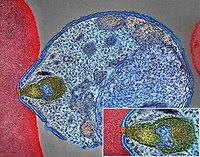
Photo from wikipedia
India, a persistently significant contributor to the global malaria burden, rolled out several anti-malaria interventions at the national and state level to control and recently, to eliminate the disease. Odisha,… Click to show full abstract
India, a persistently significant contributor to the global malaria burden, rolled out several anti-malaria interventions at the national and state level to control and recently, to eliminate the disease. Odisha, the eastern Indian state with the highest malaria burden experienced substantial gains shown by various anti-malaria initiatives implemented under the National Vector-borne Disease Control Programme (NVBDCP). However, recalcitrant high-transmission “pockets” of malaria persist in hard-to-reach stretches of the state, characterised by limited access to routine malaria surveillance and the forested hilly topography favouring unbridled vector breeding. The prevalence of asymptomatic malaria in such pockets serves as perpetual malaria reservoir, thus hindering its elimination. Therefore, a project with the acronym DAMaN was initiated since 2017 by state NVBDCP, targeting locally identified high endemic ‘pockets’ in 23 districts. DAMaN comprised biennial mass screening and treatment, provisioning of long-lasting insecticidal net (LLIN) and behavioural change communication. Subsequently, to inform policy, assessment of DAMaN was conceived that aims to estimate the coverage of the various components of the project; the prevalence of malaria, even at sub-patent level especially among pregnant/lactating women and children; and its impact on malaria incidence. A survey of DAMaN beneficiaries will measure coverage; and knowledge and practices related to LLIN; along with collection of blood specimens from a probability sample. A multi-stage stratified clustered sample of 2228 households (~33% having pregnant/lactating women) will be selected from 6 DAMaN districts. Routine DAMaN project data (2017–2018) and NVBDCP data (2013–2018) will be extracted. Rapid Diagnostic Test, Polymerase Chain Reaction and blood smear microscopy will be conducted to detect malarial parasitemia. In addition to measuring DAMaN’s coverage and malarial prevalence in DAMaN pockets, its impact will be estimated using pre-post differences and Interrupted Time Series analysis using 2017 as the “inflection” point. The assessment may help to validate the unique strategies employed by DAMaN.
Journal Title: PLoS ONE
Year Published: 2020
Link to full text (if available)
Share on Social Media: Sign Up to like & get
recommendations!